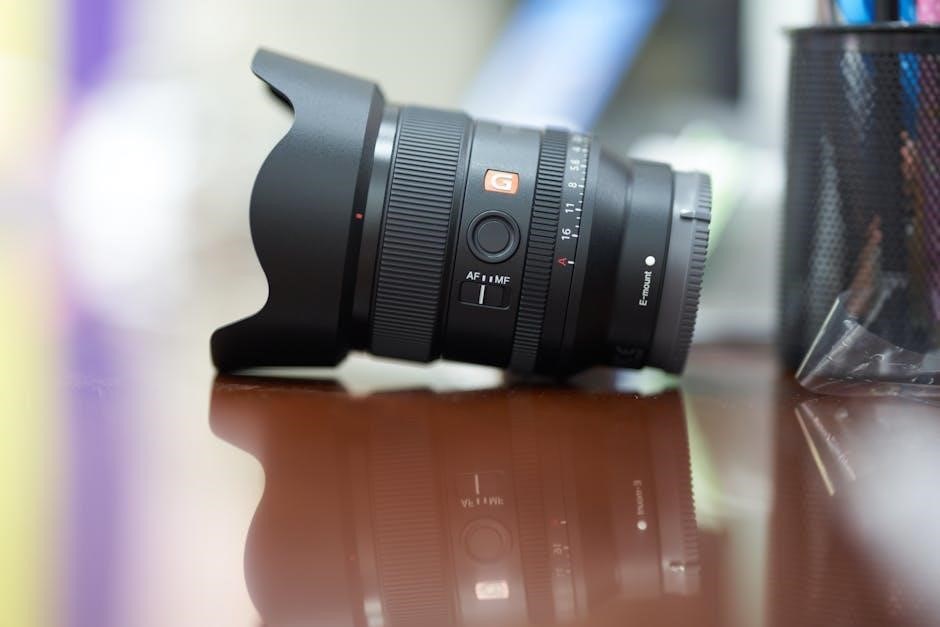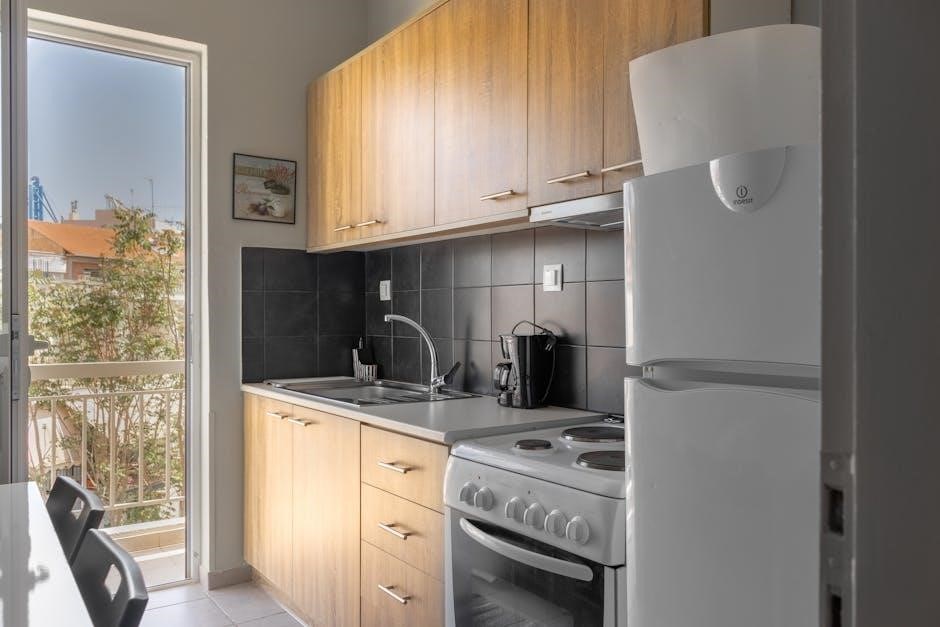Welcome to the Black and Decker Compact Refrigerator Manual! This guide provides essential information to help you understand, install, and operate your appliance safely and efficiently.

1.1 Overview of the Manual’s Purpose and Structure
This manual is designed to help users understand and make the most of their Black and Decker Compact Refrigerator. It provides clear instructions for installation, operation, and maintenance, ensuring optimal performance and safety. The guide is structured into sections, covering product features, setup, usage tips, troubleshooting, and warranty information, making it easy to navigate and find specific details quickly.
1.2 Importance of Reading the Manual for Optimal Use
Reading this manual is essential for safe and efficient operation of your Black and Decker Compact Refrigerator. It provides critical information on installation, temperature settings, and maintenance to ensure optimal performance. Understanding the guidelines helps prevent damage, reduces energy consumption, and extends the appliance’s lifespan. Familiarizing yourself with troubleshooting tips and safety precautions also ensures a smooth user experience and protects your warranty coverage.
Product Overview
The Black and Decker Compact Refrigerator is a versatile, energy-efficient appliance designed for small spaces. Available in models like BCRK17, BCRK25B, BCRK32, and BCRK43W, it offers capacities ranging from 1.7 to 4.3 cubic feet, featuring a compact design, adjustable temperature settings, and a freezer compartment for convenient storage.
2.1 Key Features of the Black and Decker Compact Refrigerator
The Black and Decker Compact Refrigerator offers a range of features, including adjustable temperature controls, a compact design, and a freezer compartment for versatile storage. Models like the BCRK17, BCRK25B, and BCRK43W provide capacities from 1.7 to 4.3 cubic feet, ensuring space-saving solutions. Energy-efficient operation, quiet performance, and easy-to-clean interiors make it ideal for small kitchens, offices, or dorm rooms. Reversible doors and shelves add flexibility for customized organization;
2.2 Available Models and Their Specifications
Black and Decker offers several compact refrigerator models, including the BCRK17 (1.7 CU. FT.), BCRK25B (2.5 cubic feet), BCRK32 (3.2 CU. FT.), and BCRK43W (4.3 CU. FT.). Each model features varying capacities, Energy Star ratings, and designs like single-door or freezer compartments. The BCRK17B, BCRK17V, and BCRK17W are popular choices, with options for reversible doors and adjustable shelves, ensuring flexibility for different spaces and needs.
Installation and Setup
Proper installation ensures optimal performance. Choose a well-ventilated area, level the appliance, and connect it to a grounded electrical outlet as specified in the manual.
3.1 Choosing the Right Location for the Refrigerator
Proper location ensures efficient operation. Place the refrigerator in a well-ventilated area, away from direct sunlight and heat sources. Ensure it is level and at least 3 inches away from walls for optimal airflow. Avoid installing near ovens or radiators to maintain consistent cooling performance. Choose a stable, firm surface to prevent vibrations and noise. This setup ensures reliability and extends the appliance’s lifespan.
3.2 Leveling the Appliance for Proper Operation
Leveling is crucial for proper operation. Place the refrigerator on a firm, even surface. Use a spirit level to ensure the appliance is perfectly horizontal. Adjust the leveling legs by turning them clockwise or counterclockwise until the unit is balanced. Proper leveling prevents door misalignment, ensures efficient cooling, and reduces noise. Double-check the surface and legs to confirm stability before final placement.
3.3 Electrical Requirements and Safety Precautions
Ensure the refrigerator is plugged into a grounded 120V AC outlet. Use a dedicated circuit to avoid power interruptions. Never use an extension cord or overload the outlet. Keep the power cord away from heat sources and water. Avoid exposing the appliance to extreme temperatures or moisture. Always unplug before cleaning or servicing. Follow safety guidelines to prevent electrical hazards and ensure efficient operation. Consult a professional if unsure about connections.

Operating the Compact Refrigerator
Understand the temperature controls and adjust settings for optimal cooling. Organize shelves to maximize storage space. Regularly check door seals to ensure proper closure and efficiency.
4.1 Understanding the Temperature Control Settings
The Black and Decker compact refrigerator features easy-to-use temperature controls that allow you to adjust settings for optimal cooling. The dial or digital interface lets you set the ideal temperature for your needs. Proper use ensures energy efficiency and maintains freshness. Always refer to the manual for specific guidance on adjusting settings for your model. Regular checks and adjustments help maintain consistent cooling performance.
4.2 Optimizing Storage Space and Organization
Maximize your Black and Decker compact refrigerator’s storage capacity by using adjustable shelves and compartments. Arrange items by size and priority to ensure efficient use of space. Keep frequently accessed items at eye level for easy access. Avoid overfilling to maintain proper airflow. Labeling contents and storing food in airtight containers can help keep your refrigerator organized and fresh for longer. Regularly clean and reorganize to maintain optimal functionality and hygiene.

Maintenance and Care
Regular cleaning of the interior and exterior ensures optimal performance. Check door seals for tightness and defrost the freezer compartment periodically to maintain efficiency and longevity.
5.1 Cleaning the Interior and Exterior
Clean the interior with a mild detergent and warm water, avoiding abrasive materials. Wipe down shelves and compartments regularly. For the exterior, use a soft cloth to remove dust and stains. Ensure the appliance is unplugged before cleaning. Avoid harsh chemicals that may damage surfaces. Regularly check and clean the condenser coils to maintain efficiency. Always dry surfaces thoroughly to prevent moisture buildup. This ensures optimal performance and longevity of your refrigerator.
5.2 Defrosting the Freezer Compartment
To defrost the freezer compartment, unplug the appliance and remove all contents. Allow ice to thaw naturally or use a towel to absorb water. Avoid using sharp objects to scrape ice, as this may damage surfaces. After defrosting, wipe the compartment with a clean, damp cloth and dry thoroughly. Regular defrosting ensures efficient operation and prevents ice buildup. Always follow safety guidelines to avoid damage or injury.
5.3 Replacing Filters and Checking Door Seals
Regularly inspect and replace the air filter to maintain optimal performance. Locate the filter, typically behind the ventilation grille, and swap it with a new one every 6-12 months. For door seals, check for cracks or wear. Clean seals with a mild detergent to ensure a tight seal. If damaged, contact Black and Decker for replacement parts to maintain energy efficiency and prevent air leaks.

Troubleshooting Common Issues
This section helps resolve common issues such as temperature fluctuations, unusual noises, and door seal malfunctions. Refer to the troubleshooting guide for quick solutions and optimal performance.
6.1 Addressing Temperature Fluctuations
If your refrigerator experiences temperature fluctuations, ensure the temperature control is set correctly. Check for proper door sealing and avoid overcrowding, as this can disrupt airflow. Verify the appliance is level and away from direct sunlight or heat sources. Refer to the troubleshooting guide for advanced solutions to maintain consistent cooling performance and optimal operation.
- Ensure the temperature setting is appropriate for your needs.
- Check for proper door sealing to maintain consistent temperatures.
- Avoid overcrowding, as it can disrupt airflow and cooling efficiency.
- Verify the appliance is level and away from direct sunlight or heat sources.
- Refer to the troubleshooting guide for advanced solutions.
6.2 Solving Noise-Related Problems
If your refrigerator is making unusual noises, check if it is properly leveled and placed on a firm surface. Ensure the appliance is installed away from walls to allow proper airflow. Loose parts or improper installation can also cause noise. Refer to the manual for guidance on addressing specific sounds, such as rattling or humming, to restore quiet operation and maintain performance.
- Ensure the refrigerator is level and firmly placed.
- Check for loose parts that may cause noise.
- Verify proper installation and spacing from walls.
- Consult the manual for troubleshooting specific sounds.
6.3 Fixing Door Seal Malfunctions
If the door seal is not sealing properly, check for dirt or debris and clean it with a mild detergent. Ensure the door aligns correctly with the frame. If the seal is damaged, replace it with a genuine Black+Decker part. A malfunctioning door seal can cause temperature fluctuations and energy inefficiency, so addressing it promptly is crucial for maintaining optimal performance.
- Clean the door seal with a mild detergent.
- Ensure the door aligns properly with the frame.
- Replace the seal with a genuine Black+Decker part if damaged.

Energy Efficiency and Safety Tips
Ensure optimal energy use by maintaining proper door seals, cleaning condenser coils regularly, and keeping the fridge away from direct sunlight or heat sources.
- Clean condenser coils to improve efficiency.
- Keep the fridge away from heat sources.
- Ensure door seals are tight to prevent air leaks.
7.1 Energy-Saving Practices
To maximize energy efficiency, clean the condenser coils regularly and ensure proper door sealing. Keep the refrigerator away from direct sunlight and heat sources to reduce energy consumption. Avoid overloading the appliance, as this can strain the compressor. Maintain optimal temperature settings to prevent excessive cooling. These practices not only save energy but also prolong the lifespan of your Black and Decker compact refrigerator.
- Clean condenser coils periodically.
- Ensure door seals are tight.
- Avoid placing near heat sources.
7.2 Safety Guidelines for Users
Always follow safety guidelines to ensure safe operation. Avoid exposing the appliance to water or using it near flammable materials. Keep children away from the refrigerator and ensure it is installed on a stable, level surface. Never modify the appliance or use damaged power cords. Properly unplug before cleaning or maintaining. Follow all manufacturer instructions to prevent accidents and ensure longevity of the product.
- Avoid water exposure to prevent electrical hazards.
- Keep the appliance upright during transport.
- Ensure proper ventilation for safe operation.

Warranty and Customer Support
Black and Decker provides a comprehensive warranty and dedicated customer support. Visit www.blackanddecker.com for details, or contact their support team for assistance with your compact refrigerator.
8.1 Understanding the Warranty Terms
Black and Decker offers a comprehensive warranty for their compact refrigerators. The warranty covers manufacturing defects for a specified period, ensuring your product is free from defects in materials and workmanship. Be sure to register your product and retain the purchase receipt for warranty validation. Refer to the manual or visit www.blackanddecker.com for detailed terms and conditions. Proper product registration ensures smooth warranty claims processing.
8.2 Contacting Black and Decker Customer Service
For assistance, visit the official Black and Decker website at www.blackanddecker.com. Navigate to the “Support” or “Contact Us” section for customer service inquiries. You can also access the Black and Decker Instant Answers website for troubleshooting guides and FAQs. Additionally, product registration and warranty-related queries can be addressed through their online portal. For direct support, refer to the contact details provided in your product manual.
By following this manual, you’ll optimize your Black and Decker Compact Refrigerator’s performance. Proper installation, maintenance, and usage ensure energy efficiency, safety, and longevity. Happy cooking!
9.1 Recap of Key Points
Your Black and Decker Compact Refrigerator manual provides essential guidance for installation, operation, and maintenance. Key points include proper location selection, leveling, and electrical requirements. Regular cleaning, defrosting, and checking door seals ensure optimal performance. Energy-saving practices and safety tips are emphasized. Troubleshooting common issues like temperature fluctuations and noise is also covered. Refer to the manual for model-specific instructions and warranty details to ensure long-term satisfaction and efficiency.
9.2 Final Tips for Long-Term Use
To ensure your Black and Decker Compact Refrigerator performs optimally, maintain regular cleaning schedules, check door seals for tightness, and store items properly. Avoid overloading to preserve airflow and efficiency. Keep the unit away from direct sunlight and heat sources. Refer to the manual for model-specific care instructions and follow safety guidelines to extend the appliance’s lifespan and reliability. Consistent upkeep ensures years of dependable service.
